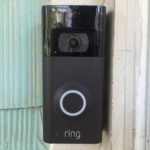As one of the Block Watch organizers, I was recently approached by one of the Columbus Police Community Liaison Officers to see if I was interested in a free Ring 2 Doorbell. I already have a few video cameras installed on my home from two different manufacturers and types, and figured it would be a good idea to try out this system as well. My goal is to try as many of the various systems that I can in order to better offer potential solutions to residents that ask about camera systems.
Let me start by saying that privacy of my neighbors is very important to me, and I will never use video to spy on or share non crime related video. I would hope my neighbors have the same consideration as well. But after reading an article on CNET about Amazon’s helping police build a surveillance network with Ring doorbells, I was starting to wonder how much of our privacy is at stake here. How easy or willing my neighbors are at sharing video is not a surprise based upon what I have seen on Facebook.
However, Ring (now owned by Amazon) has made it very clear that law enforcement is not allowed to provide cameras to its community with any strings attached about a requirement to share video. Ring is clear that all video can only be shared by the owner of the device and only at their will. No personal information is provided with the video, just a general location.
So, what is the value that law enforcement receives from providing devices to the community? Ring provides a law enforcement dashboard in the Neighbors App, that allows them to see anything that is posted publicly to help police coordinate responses to crimes. They do not have access to exact locations or members names, but it doesn’t stop police from going door to door to ask for further information from willing neighbors. It appears that the extra information from shared video has helped police solve some crimes.
What is the value to our neighbors? The Neighbors App is one of the key components to the Ring network. The app can be downloaded for free by anyone. You do not need to have a Ring device to become a member. The app allows you to plug in your location and limit the size of area you want to receive alerts about. You can receive notifications on your phone when a neighbor posts something publicly to the app network you belong to. I like this better than Facebook groups or Nextdoor.com because of the anonymous nature of posts, but you can still get relevant information about crimes or missing persons alerts.
As of July 2019, I am still in the free trial mode of the device where I can retrieve recorded videos from the device that was triggered by motion detection. I am awaiting the end of the trial so that I can see and test the functionality of the device if I do not go ahead and pay the monthly service fee to Amazon, which as of today is only $3 per month per device up to $10 for multiple devices. I will add to this article and compare the difference after a mont of testing.
Overall, I have been very impressed by the device, despite its $200 price tag. I have purchased full systems with a recording DVR and 4 cameras for under $500. However, the Ring device was far simpler to setup and had no extra wiring. I only need to charge the internal battery, which as of today has already lasted two weeks and still above half charge. Ring states that depending upon the number of alerts, which I get approximately 10 per day myself, the battery could last several weeks to a couple months before needing recharged. Replacement batteries are not expensive and just as easy to have an extra one on hand ready to go as it seems to take a couple days to charge using my laptop’s USB port.
Thanks to the City of Columbus Police department for letting me test this device, and I look forward to providing more feedback about it as I continue to test and play.
